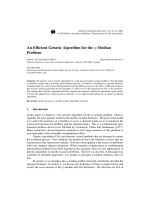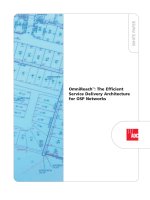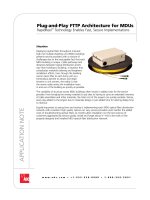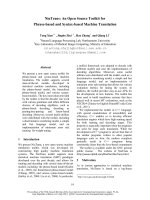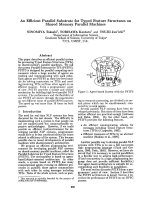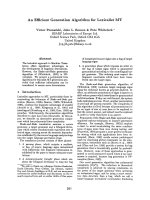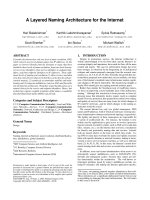AN EFFICIENT HARDWARE ARCHITECTURE FOR HMM BASED TTS SYSTEM
Bạn đang xem bản rút gọn của tài liệu. Xem và tải ngay bản đầy đủ của tài liệu tại đây (707.8 KB, 6 trang )
Báo cáo toàn văn Kỷ yếu hội nghị khoa học lần IX Trường Đại học Khoa học Tự nhiên, ĐHQG-HCM
VIII-O-2
AN EFFICIENT HARDWARE ARCHITECTURE FOR HMM-BASED TTS SYSTEM
Su Hong Kiet1, Huynh Huu Thuan1, Bui Trong Tu1
1
University of Natural Sciences, VNU-HCM
ABSTRACT
This work proposes a hardware architecture for HMM-based text-to-speech synthesis system
(HTS). In high speed platforms, HTS with software core-engine can satisfy the requirement of realtime processing. However, in low speed platforms, software core-engine consumes long time-cost to
complete the synthesis process. A co-processor was designed and integrated into HTS to accelerate
the performance of system.
Keywords: text-to-speech synthesis, HMM, HTS, SoPC, FPGA.
INTRODUCTION
A HTS consists two parts of training part and synthesis part as show in Figure 1. In training part, a contextdependent HMM database is trained from speech database. Trained context-dependent HMM database consists
of models for spectrum, pitch and state duration; and decision trees for spectrum, pitch and state duration. Then,
the trained context-dependent HMM database is used by synthesis part to generate speech waveform from given
text.
Figure 1. Scheme of HTS
In synthesis part, given text is analyzed and converted into label sequence. According to label sequence,
HMM sentence is constructed by concatenating HMMs taken form trained HMM database. And then, excitation
and spectral parameters are extracted from HMM sentence. Excitation and spectral parameters are fed to
synthesis filter to synthesize speech waveform. Depending on the fact that spectral parameter is presented as
mel-cesptral coefficients or mel-generalized cepstral coefficients, synthesis filter is constructed as MLSA filter
or MGLSA filter, respectively.
In recent research, HTS is applied to many languages such as Japanese [1], English [1], Korean [13],
Arabic [14] and so on. Moreover, thank to the small-size of core-engine, HTS can be implemented on various
devices such as personal computer, server and so on. On high speed platforms such as PC, HTS with software
core-engine can satisfy requirement of real-time processing. In contrast, on low speed platforms, software coreengine consumes long time-cost to convert text to speech, i.e., the system do not meet real-time processing. In
ISBN: 978-604-82-1375-6
15
Báo cáo toàn văn Kỷ yếu hội nghị khoa học lần IX Trường Đại học Khoa học Tự nhiên, ĐHQG-HCM
order to implement an efficient HTS on low speed platforms, speeding up the performance of core-engine is on
demand. This work uses a co-processor to accelerate the performance of HTS built on FPGA-based platform.
The rest of this paper is organized as follow: Section 2 presents the co-processor for HTS. Section 3
proposes a hardware architecture for HTS built on FPGA-based platform. Section 4 presents experiment for
evaluating the performance of proposed system.
CO-PROCESSOR FOR HTS
HTS Working Group have been developing a software core-engine for HTS (HTS-engine) [10]. HTSengine provides functions to generate speech waveform from label sequence by using a trained contextdependent HMM database. The process of generating speech waveform from label sequence can be split into
three steps as follow:
•Step 1: parsing label sequence and creating the HMM sentence.
•Step 2: generating speech parameters from HMM sentence.
•Step 3: generating speech waveform (synthesized speech) from speech parameters.
The evaluation of performance of HTS-engine on various platforms shows that time-cost for Step-1 is
small, Step-2 and Step-3 consume about 10% and 90% of total time-cost, respectively [15]. The performance of
HTS-engine on FPGA-based platform is shown in Table 1.
Table 1. Performance of HTS-engine on FPGA-based platform
FPGA device
System
configuration
Synthesized
speech
Time-cost (s)
R IV 4CE115
Altera Cyclone○
FPGA chip
Nios-II with
CPU
-Floating point hardware
-Instruction cache: 4KB
-Data cache: 2KB
Frequency
125 MHz
Instruction storage
SRDAM
SDRAM
Data storage
Flash memory for storing
trained HMM database
144,240 samples which correspond to 3.005s of
speech. (Note: sampling rate is set as 48 KHz)
Step 1
0.25
Step 2
2.77
Step 3
34.27
Table 1 shows that time-cost in FPGA-based platform is much larger than the length of synthesized speech
(above ten times). In order to accelerate the system performance, a co-processor is designed to take place HTSengine to carry out Step-2 and Step-3. Step-1 is still carried out by HTS-engine to maintain the flexibility of
system. Architecture of the co-processor is shown in Figure 2.
Figure 2. Architecture of co-processor
Speech parameter generator (SPG) carries out the processing of generating speech parameters from
means and variances of states in the constructed HMM sentence. The detailed architecture of SPG is shown in
ISBN: 978-604-82-1375-6
16
Báo cáo toàn văn Kỷ yếu hội nghị khoa học lần IX Trường Đại học Khoa học Tự nhiên, ĐHQG-HCM
Figure 3-a. SPG consists of an arbiter and five sub-modules. The arbiter communicates with main CPU via
Avalon bus and controls the operation of sub-modules via an internal bus. Each sub-module carries out its own
specified task and activated by the arbiter. After a sub-module completes its task, it informs the arbiter. And
then, the arbiter deactivates the sub-module.
(a)
(b)
Figure 3. Architecture of SPG (a) and SSG (b)
Synthesized speech generator (SSG) carries out the processing of generating synthesized speech from
speech parameters. Similar to SPG, SSG consists of an arbiter and several sub-modules. The arbiter
communicates with main CPU via Avalon bus and controls the operation of sub-modules via an internal bus.
Each sub-module carries out its own specified task and activated by the arbiter. After a sub-module completes its
task, it informs the arbiter. And then, the arbiter deactivates the sub-module. Detailed architecture of SSG is
shown in Figure 3-b.
Floating point unit (FPU) is integrated into the co-processor to support SPG and SSG to carry out
operations in floating point numbers. FPU supports operations of addition, subtraction, multiplication, division,
modulo, comparison, exponential, natural logarithm and cosine. FPU is shared for the arbiters and sub-modules
of SPG and SSG. In order to avoid the conflict, at any time, at most one arbiter or one sub-module can use FPU,
i.e., other arbiters and sub-modules must release the FPU interface bus.
Internal memory stores data which are used or created by SPG or SSG. Similar to FPU, the internal
memory is a shared resource. At any time, at most one arbiter or one sub-module can access the internal
memory, i.e., other arbiters and sub-modules must release the internal memory interface bus.
HARDWARE ARCHITECTURE FOR HTS
Figure 4 shows the hardware architecture for HTS built on FPGA-based platform, in which a co-processor
is integrated into the system to accelerate system peformance. Nios-II CPU is the main CPU of the system.
SDRAM is instruction storage and data storage of the system. PLLs are used for setting the frequency of clocks
in the system. UART port is used for debug mode. This architecture consists of synthesis part of HTS only, i.e.,
it do not consists of training part. So the proposed system need a trained context-dependent HMM database.
Since the HMM database is saved in files, a flash memory is used to store the HMM database so that we can use
read only zip file system (which is supported by Altera) to load data from the HMM database.
ISBN: 978-604-82-1375-6
17
Báo cáo toàn văn Kỷ yếu hội nghị khoa học lần IX Trường Đại học Khoa học Tự nhiên, ĐHQG-HCM
Figure 4. Hardware architecture for HTS
EXPERIMENT
Building the proposed system shown in Figure 4 on Stratix IV FPGA development board, in which input
text device is a touch-screen, audio output device is a DAC card connecting to a speaker. Performance of system
is shown in Table 2.
Table 2. Performance of HTS on FPGA-based platform with a co-processor
Input text
Synthesized speech
(Sampling rate = 38 KHz)
Number of
samples
Time-cost
(s)
Length (s)
bộ giáo dục và đào tạo
95040
2.501
2.462
đại học khoa học tự nhiên
95040
2.501
2.428
đại học tự nhiên
74880
1.970
1.882
thuê bao vừa được gọi
không liên lạc được
116640
3.069
3.040
thành phố hồ chí minh
ngày mùng hai tháng chín
128460
3.381
3.375
Table 2 shows that performance time-cost is smaller than the length of synthesized speech, i.e., the
requirement of real-time processing is met. Comparing to the system which do not have co-processor, the
performance time-cost is reduced significantly. When co-processor is not used, the performance time-cost is
above ten times larger than the length of synthesized speech. But after integrating co-processor into the system
and setting system configuration appropriately, performance time-cost can decrease to a value smaller than the
length of synthesized speech.
Moreover, synthesized speech is intelligible and has the same quality to the speech synthesized by HTS
built on PC-platform. Denoting waveforms which generated from the same input text by the proposed HTS and
HTS built on PC-platform by 𝑋1 and 𝑋2 , respectively.
𝑋1 = [𝑥11 , 𝑥12 , … , 𝑥1𝑁 ]
𝑋2 = [𝑥21 , 𝑥22 , … , 𝑥2𝑁 ]
ISBN: 978-604-82-1375-6
18
Báo cáo toàn văn Kỷ yếu hội nghị khoa học lần IX Trường Đại học Khoa học Tự nhiên, ĐHQG-HCM
where 𝑥1𝑖 and 𝑥2𝑖 with 𝑖 = 1, 2, … , 𝑁 are samples of 𝑋1 and 𝑋2 , respectively.
Mean square error (MSE) between two vectors 𝑋1 and 𝑋2 is calculated as following equation
𝑁
𝑀𝑆𝐸 =
1
∑(𝑥1𝑖 − 𝑥2𝑖 )2
𝑁
(1)
𝑖=1
(a)
(b)
Figure 5. Waveform generated from the input text ” bộ giáo dục và đào tạo”
by proposed HTS (a) and HTS built on PC-platform (b)
Applying Eq.-1 to waveforms which are generated from different input text, we obtain the result in Table 3.
Table 3. Mean square error between waveforms generated by proposed HTS and HTS built on PC-platform
Input text
MSE
bộ giáo dục và đào tạo
0.034
đại học khoa học tự nhiên
0.020
đại học tự nhiên
0.022
thuê bao vừa được gọi
không liên lạc được
0.045
thành phố hồ chí minh
ngày mùng hai tháng chín
0.038
Table 3 shows that the MSEs between two systems are smaller than 4,5%, i.e., waveforms generated from
two systems are alike.
CONCLUSIONS
An efficient hardware architecture for HTS built on FPGA-based platform was proposed by this work. In
the proposed architecture, a co-processor is used to accelerate the performance of the system. Experiment results
show that using co-processor decrease performance time-cost significantly. It leads the system meets the
requirement of real-time processing. Moreover, speech synthesized by the proposed system is intelligible and
has a waveform alike to one which is generated by HTS built on PC-platform.
REFERENCES
[1]. Tokuda K., Zen H., & Black A. W. (2002, September). An HMM-based speech synthesis system applied
to English. In Speech Synthesis, 2002. Proceedings of 2002 IEEE Workshop on (pp. 227-230). IEEE.
[2]. Tokuda K., Masuko T., Miyazaki N., & Kobayashi T. (2002). Multi-space probability distribution HMM.
IEICE TRANSACTIONS on Information and Systems, 85(3), 455-464.
[3]. Tokuda K., Masuko T., Miyazaki N., & Kobayashi T. (1999, March). Hidden Markov models based on
multi-space probability distribution for pitch pattern modeling. In Acoustics, Speech, and Signal
Processing, 1999. Proceedings., 1999 IEEE International Conference on (Vol. 1, pp. 229-232). IEEE.
[4]. Yoshimura, T., Tokuda, K., Masuko, T., Kobayashi, T., & Kitamura, T. (1998, December). Duration
modeling for HMM-based speech synthesis. In ICSLP (Vol. 98, pp. 29-31).
[5]. Yoshimura T., Tokuda K., Masuko T., Kobayashi T., & Kitamura T. (1999). Simultaneous Modeling of
Spectrum, Pitch and Duration in HMM-Based Speech Synthesis. In Sixth European Conference on
Speech Communication and Technology.
ISBN: 978-604-82-1375-6
19
Báo cáo toàn văn Kỷ yếu hội nghị khoa học lần IX Trường Đại học Khoa học Tự nhiên, ĐHQG-HCM
[6]. Tokuda K., Yoshimura T., Masuko T., Kobayashi T., & Kitamura T. (2000, June). Speech parameter
generation algorithms for HMM-based speech synthesi s. In Acoustics, Speech, and Signal Processing,
2000. ICASSP’00. Proceedings. 2000 IEEE International Conference on (Vol. 3, pp. 1315-1318). IEEE.
[7]. Fukada T., Tokuda K., Kobayashi T., & Imai S. (1992, March). An adaptive algorithm for mel-cepstral
analysis of speech. In Acoustics, Speech, and Signal Processing, 1992. ICASSP-92., 1992 IEEE
International Conference on (Vol. 1, pp. 137-140). IEEE.
[8]. Tokuda K., Kobayashi, T. Masuko, T., & Imai S. (1994, September). Mel-generalized cepstral analysis-a
unified approach to speech spectral estimation. In ICSLP.
[9]. SPTK Working Group. (2013, December). Reference Manual for Speech Signal Processing Toolkit Ver
3.7. />[10]. HTS Working Group. HMM-based Speech Synthesis Engine (hts_engine API) Ver. 1.06.
/>[11]. Pham N. M., Dau D. N., & Vu Q. H. (2013). Distributed Web Service Architecture Towards Robotic
Speech Communication: A Vietnamese Case Study. Int J Adv Robotic Sy, 10(130).
[12]. Taylor P. (2009). Text-to-speech synthesis. Cambridge University Press.
[13]. Kim S. J., Kim J. J., & Hahn M. (2006). HMM-based Korean speech synthesis system for hand-held
devices. Consumer Electronics, IEEE Transactions on, 52(4), 1384-1390.
[14]. Khalil K. M., & Adnan C. (2013, March). Arabic HMM-based speech synthesis. In Electrical Engineering
and Software Applications (ICEESA), 2013 International Conference on (pp. 1-5). IEEE.
[15]. Nguyen H. B., Cao T. B. T., Bui T. T.,& Huynh H. T (2013, November). A Performance Evaluation of
HMM Based Text- to- Speech System on Various Platforms. Proceedings of ICDV-2013, pp. 265-267.
ISBN: 978-604-82-1375-6
20

